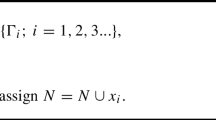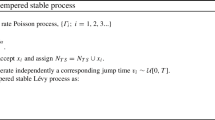Abstract
In this note we will contextualize the recently established Wiener–Hopf Monte Carlo (WHMC) simulation technique for Lévy processes from Kuznetsov et al. (Ann Appl Probab 21(6):2171–2190, 2011), into a more general framework allowing us to use the same technique in a larger set of problems. We will briefly show how the scheme can be used to approximate Lévy driven SDEs or how to approximate different types of path dependent quantities. In a way, the present note summarizes and connects a set of results contained in Ferreiro-Castilla et al. (Stochastic Process Appl 124(2):985–1010, 2014; J Appl Probab 52(1):129–148, 2015; J Appl Probab 53(1):262–278, 2016); therefore we intentionally leave most of the technicalities aside for this note.
Access provided by CONRICYT-eBooks. Download conference paper PDF
Similar content being viewed by others
Keywords
- Path-dependent Quantities
- Appl Probab
- Wiener-Hopf Factorization
- Deterministic Discretization
- Running Supremum
These keywords were added by machine and not by the authors. This process is experimental and the keywords may be updated as the learning algorithm improves.
1 Introduction
Let X: = (X t ) t ≥ 0 be a Lévy process, i.e. a (real valued) stochastic process starting from 0 with cadlag paths (right continuous and with left limits) and stationary, independent increments. The Lévy–Khintchine formula entails that the characteristic exponent \(\Psi \), defined as \(\mathbb{E}[e^{\mathrm{i}zX_{t}}] = e^{-t\Psi (z)}\) for all t ≥ 0 and \(z \in \mathbb{R}\), can be expressed as
where \(\sigma,a \in \mathbb{R}\) and \(\Pi \) is a measure on \(\mathbb{R}\setminus \{0\}\) satisfying \(\int _{\mathbb{R}\setminus \{0\}}(x^{2} \wedge 1)\Pi (\mathrm{d}x) < \infty \).
Of interest in several fields are quantities depending on the path of X, the complete path of X is numerically intractable and, ultimately, any numerical scheme can only be based on simulating the increments of the driving process. A first approach consists in computing an Euler skeleton of the path; but even for a Brownian motion, where the Euler scheme is exact, computing a simple supremum in this way leads to a significant bias (see Broadie–Glasserman–Kou [1]) due to the fact that the skeleton misses the excursions of the process. In this note we are interested in constructing a skeleton for the path based on the Wiener–Hopf factorization. Suppose that, for any q > 0, e(q) is an exponentially distributed random variable with mean q −1 that is independent from X. Recall that \(\overline{X}_{t}\,:=\,\sup _{s\leq t}X_{s}\) and let \(\underline{X}_{t}\,:=\,\inf _{s\leq t}X_{s}\). The Wiener–Hopf factorization states that the random variables \(\overline{X}_{\mathbf{e}(q)}\) and \(\overline{X}_{\mathbf{e}(q)} - X_{\mathbf{e}(q)}\) are independent. Thanks to the so-called principle of duality, that is to say the equality in law of the pair {X (t−s)−− X t : 0 ≤ s ≤ t} and { − X s : 0 ≤ s ≤ t}, it follows that \(\overline{X}_{\mathbf{e}(q)} - X_{\mathbf{e}(q)}\) is equal in distribution to \(-\underline{X}_{\mathbf{e}(q)}\). This leads to the following factorization of characteristic functions
for all \(\theta \in \mathbb{R}\), known as the Wiener–Hopf factorization. Equivalently,
where S q and I q are independent and equal in distribution to \(\overline{X}_{\mathbf{e}(q)}\) and \(\underline{X}_{\mathbf{e}(q)}\), respectively. Here, we use the notation \(\stackrel{d}{=}\) to mean equality in distribution.
The above factorization captures in one time step the nature of the path; i.e. knowing the supremum and the infimum one would be able to answer questions relating whether the process crossed a barrier or whether there was a big jump in the time step. Obviously, the time step is itself a random variable but, thanks to the equality
we can create a random partition of the interval [0, 1] with a mesh size \(\mathbb{E}[ \frac{1} {n}\mathbf{e}_{i}(1)]\rightarrow 0\) as n ↑ ∞. We call our method the Euler–Poisson scheme, as one can think of the random partition as given by the arrival times of a Poisson process.
For the sake of simplicity, recall that \(\sum _{i=1}^{k} \frac{1} {n}\mathbf{e}_{i}(1)\) has the same distribution as a Gamma random variable which will be denoted by g(k, n). Therefore the Euler–Poisson scheme of the process X refers to the skeleton \(\{X_{\mathbf{e}_{k}(1/n)}\}_{k\geq 0}\) or {X g(k, n)} k ≥ 0.
1.1 Heuristics Behind the Scheme
Let us give a brief discussion of the heuristics of the Euler–Poisson scheme and an idea why this scheme should be a particular good approach to compute path dependent quantities of Lévy processes.
It can be inferred from Doney [3] that, for all k > 0, the random variables
can be written as
respectively, where {Y k (+)} k ≥ 0 and {Y k (−)} k ≥ 0 are random walks with the same distribution as {X g(k, n)} k ≥ 0, and independent from S 0 (n) and I 0 (n), respectively. Since it is clear that m k ≤ X t ≤ M k for g(k, n) ≤ t < g(k + 1, n), the derivations in Doney [3] assert that it is possible to ‘stochastically’ bound the path of X from above and below by two random walks which are equal in distribution to the skeleton proposed in this paper, but with different random starting points.
There is yet another heuristic justification to support the skeleton {X g(k, n∕t)} k ≥ 0 as a good random walk approximation of the Lévy process to compute pathwise quantities. The Feynman–Kac representation identifies conditional expectations of functionals of the solution of a Stochastic Differential Equation (SDE) as solutions of a certain Partial Integro Differential Equation (PIDE). We claim that, in some sense, the solution of a Lévy driven SDE sampled over a random grid generated by the arrival times of a Poisson process is equivalent to performing a discretization in time by the method of lines to the associated Feynman–Kac equation. We are not the first to point out this relationship. It was the basis of Carr [2], where an approximation for American options of finite maturity is obtained by randomizing the time horizon by an Erlang distribution. Matache–Nitsche–Schwab [9] also pointed out, informally, the relation between a deterministic discretization in time of a Feynman–Kac PIDE and its probabilistic counterpart. Details on this relationship can be found in Ferreiro-Castilla–Kyprianou–Scheichl [6].
1.2 Feasibility of the Scheme
It is clear from the preceding section that the Euler–Poisson method is of practical interest only if samples from the distribution of X e(q) are available. In general, there is no reason why the latter distribution is easier to handle than the distribution of X 1 itself, needed to set up a plain Euler scheme for a Lévy process. Nevertheless, recent developments in Wiener–Hopf theory for one dimensional Lévy processes have provided a rich enough variety of examples for which the necessary distributional sampling can be performed and thus the Euler–Poisson scheme may lead to simpler numerical techniques. This family of processes are called meromorphic Lévy processes; see Kuznetsov et al. [7, 8]. For the class of meromorphic Lévy processes, the Wiener–Hopf factors are explicit and hence we can efficiently sample from the distribution of X e(q) through its factorization. One of the main advantages of the Euler–Poisson algorithm is its robustness with respect to the jump structure; see, for example, Ferreiro-Castilla–Kyprianou–Scheichl–Suryanarayana [4]. Recall that many numerical algorithms to approximate the path of a Lévy process depend on the structure of the jump component of (1).
2 Applications
Let us now give a taste of what you can do with the Euler–Poisson scheme. For a comprehensive exposition of the scheme and a range of applications we refer the reader to the papers mentioned in the abstract. Assume then that we have an algorithm to perform the Wiener–Hopf factorization of a Lévy process, then we can keep track of pairs of the type \(\{(X_{g(k,n/t)},\overline{X}_{g(k,n/t)})\}_{k\geq 0}\) or \(\{(X_{g(k,n/t)},\underline{X}_{g(k,n/t)})\}_{k\geq 0}\). It is worth noting that the theory does not allow to keep track of the exact supremum and the infimum of the process simultaneously.
2.1 Computing the First Passage Time
We will give an example of how to use the scheme to compute the first passage time over a level u > 0, i.e., τ u : = inf{t > 0∣X t > u}. Assume you can compute the Wiener–Hopf factorization for X and keep track of the running supremum, i.e., the sequence \(\{\overline{X}_{g(k,n/t)}\}_{k\geq 0}\), then
is an approximation of τ u . Indeed,
Theorem 1 (Ferreiro-Castilla–van Schaik, [5])
Using the same notation as above, we have
2.2 Approximation of Lévy Driven SDEs
Since we have now an skeleton for the path of a Lévy process, it is natural to investigate its behaviour in approximating Lévy driven SDEs. Let Y be the strong solution of
for t ∈ [0, T]. The Euler–Poisson scheme is then given by the discrete Markov chain \(\widetilde{Y }:=\{\widetilde{ Y }_{t_{i}}\}_{i\geq 0}\) defined recursively by
for i ≥ 1 and \(\widetilde{Y }_{0}:= y_{0}\), where \(\Delta X_{\mathbf{e}_{i}}:= X_{\mathbf{e}_{i}(n/T)} - X_{\mathbf{e}_{i-1}(n/T)}\stackrel{d}{=}X_{\mathbf{e}(n/T)}\) and t i : = ∑ j = 0 i e j (n∕T). We claim that \(\widetilde{Y }_{t_{n}}\) is an approximation of Y T . Indeed,
Theorem 2 (Ferreiro-Castilla–Kyprianou–Scheichl, [6])
Let X have second finite moments, and a(x) in (2) be a Lipschitz function with constant K. Then
where \(\widetilde{K}\) is a constant depending only on K and T.
References
M. Broadie, P. Glasserman, and S.G. Kou, “Connecting discrete and continuous path-dependent options”, Finance Stoch. 3 (1999), 55–82.
P. Carr, “Randomization and the American Put”, Rev. Fin. Studies 11 (3) (1998), 597–626.
R.A. Doney, “Stochastic bounds for Lévy processes”, Ann. Probab. 32 (2) (2004), 1545–1552.
A. Ferreiro-Castilla, A.E. Kyprianou, R. Scheichl, and G. Suryanarayana, “Multilevel Monte Carlo simulation for Lévy processes based on the Wiener–Hopf factorization”, Stochastic Process. Appl. 124 (2) (2014), 985–1010.
A. Ferreiro-Castilla and K. van Schaik, “Applying the Wiener–Hopf Monte Carlo simulation technique for Lévy processes to path functionals”, J. Appl. Probab. 52 (1) (2015), 129–148.
A. Ferreiro-Castilla, A.E. Kyprianou, and R. Scheichl, “An Euler–Poisson scheme for numerical approximation of Lévy driven SDEs”, J. Appl. Probab. 53 (1) (2016), 262–278.
A. Kuznetsov, A.E. Kyprianou, J.C. Pardo, and K. van Schaik, “A Wiener–Hopf Monte Carlo simulation technique for Lévy process”, Ann. Appl. Probab. 21 (6) (2011), 2171–2190.
A. Kuznetsov, A.E. Kyprianou, and J.C. Pardo, “Meromorphic Lévy processes and their fluctuation identities”, Ann. Appl. Probab. 22 (3) (2012), 1101–1135.
A.M. Matache, P.A. Nitsche, and C. Schwab, “Wavelet Galerkin pricing of American options on Lévy driven assets”, Quantitative Finance 5 (4) (2005), 403–424.
Acknowledgements
Part of this research was supported by a Royal Society Newton International Fellowship.
Author information
Authors and Affiliations
Corresponding author
Editor information
Editors and Affiliations
Rights and permissions
Copyright information
© 2017 Springer International Publishing AG
About this paper
Cite this paper
Ferreiro-Castilla, A. (2017). Euler–Poisson Schemes for Lévy Processes. In: Díaz, J., Kirousis, L., Ortiz-Gracia, L., Serna, M. (eds) Extended Abstracts Summer 2015. Trends in Mathematics(), vol 6. Birkhäuser, Cham. https://doi.org/10.1007/978-3-319-51753-7_18
Download citation
DOI: https://doi.org/10.1007/978-3-319-51753-7_18
Published:
Publisher Name: Birkhäuser, Cham
Print ISBN: 978-3-319-51752-0
Online ISBN: 978-3-319-51753-7
eBook Packages: Mathematics and StatisticsMathematics and Statistics (R0)




